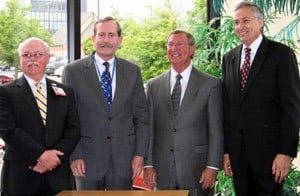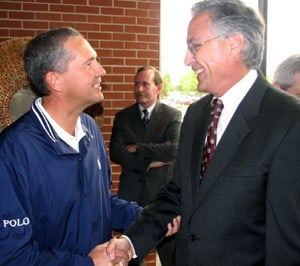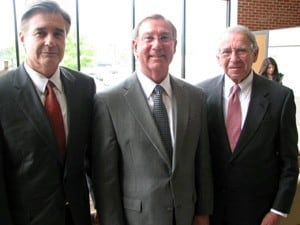Foundation Gift Tops $1 Million to UAMS AHEC in Jonesboro
April 19, 2010 | A gift to the University of Arkansas Foundation Inc. from the Judd Hill Foundation Trust today establishes a $1 million endowment for the University of Arkansas for Medical Sciences’ (UAMS) Area Health Education Center (AHEC) Northeast in Jonesboro. The endowment, which constitutes the largest gift to any of the eight UAMS AHECs, was signed at a ceremony attended by UAMS Chancellor Dan Rahn, M.D., Ron Cole, director of AHEC Northeast, Mike Gibson, trustee of the Judd Hill Foundation Trust and other UAMS officials. Interest earned from the endowment will support the AHEC’s recruitment of students into health care fields and the AHEC’s many education programs, which provide family medicine residency training as well as programs for students of nursing, pharmacy, medicine and allied health care fields. Rahn thanked Gibson for the Judd Hill Foundation Trust’s 15 years of generous support of the Jonesboro AHEC. “Gifts like this are so important to UAMS’ AHEC mission to make quality health care available throughout Arkansas,” Rahn said. “We are grateful that the Judd Hill Foundation Trust recognizes that many of the AHEC graduates here go on to practice in rural areas around Jonesboro.” Gibson said the AHEC’s mission fits perfectly with that of the foundation trust and the vision of the late Esther Hill Chapin, who gave her entire estate to the Judd Hill Foundation Trust when she died in 1991. “Esther Chapin, having lived in a rural area, was keenly aware of the great need for rural health care,” Gibson said. “And one of the purposes of the Judd Hill Foundation Trust has been to promote health and to enhance the delivery of health care services to the residents of Arkansas.” The Judd Hill Foundation was created by Chapin in 1985. The principal asset of her estate when she died was the 4,000 acre Judd Hill Plantation near Trumann, which was given to her by her father – Judd Hill – as a wedding gift. The farm now produces about 3,800 acres of cotton, corn and soybeans annually. The UAMS AHECs were set up around the state starting in 1973 to get more family medicine doctors into rural communities. As envisioned, hundreds of family medicine graduates have chosen to stay in their host AHEC communities after fulfilling their three-year residency requirement. Ron Cole, director of AHEC-Northeast, said that with the nation’s baby boomers set to enter their golden years, it’s imperative that more people be recruited into primary health care fields. “The additional resources as a result of this endowment will allow us to sustain our outreach efforts to address the looming shortage of health care professionals,” Cole said. “We reach out to students in junior high, high school and college, offering education about health care opportunities, shadowing health care providers and preparatory courses like MCAT (Medical College Admissions Test).” Mark Mengel, M.D., executive director of the UAMS AHEC Program and vice chancellor for Regional Programs, said the support of community partners and philanthropy is critical to all eight AHECs. He noted that other sources of revenue are declining. For example, after adjusting for inflation, clinical fees paid to primary care physicians has declined 25 percent since 1997. That’s important to the AHECs because 40 percent of the program’s income comes from clinical revenue. “You can only cut back so much before you start losing quality, and family medicine residency education, which is a principal mission of the AHECs, is a competitive business,” Mengel said. “So we have to keep our programs strong and of high quality, and without philanthropy it would be very difficult to do in this day and age.” In addition to clinical income, the AHECs rely on funding from the state, 30 percent; local partner hospitals, 25 percent; and grants, contracts and gifts, 5 percent. Other AHEC locations are Batesville/Mountain Home, El Dorado, Fayetteville, Fort Smith, Helena-West Helena, Pine Bluff and Texarkana. UAMS is the state’s only comprehensive academic health center, with colleges of Medicine, Nursing, Pharmacy, Health Related Professions and Public Health; a graduate school; a 540,000-square-foot hospital; six centers of excellence and a statewide network of regional centers. UAMS has 2,775 students and 748 medical residents. Its centers of excellence include the Winthrop P. Rockefeller Cancer Institute, the Jackson T. Stephens Spine & Neurosciences Institute, the Myeloma Institute for Research and Therapy, the Harvey & Bernice Jones Eye Institute, the Psychiatric Research Institute and the Donald W. Reynolds Institute on Aging. It is the state’s largest public employer with more than 10,000 employees, including nearly 1,150 physicians who provide medical care to patients at UAMS, Arkansas Children’s Hospital, the VA Medical Center and UAMS’ Area Health Education Centers throughout the state. Visit www.uams.edu or uamshealth.com. |



